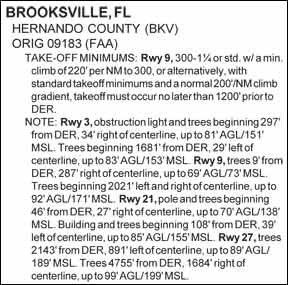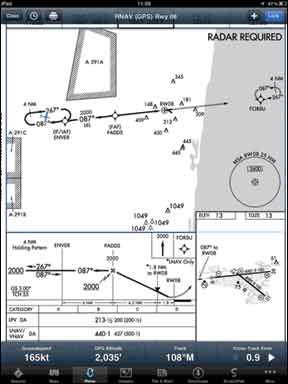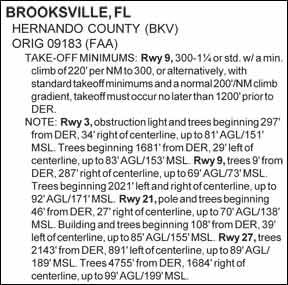If youre like many of us, the back-and-forth radio chatter between pilots and controllers leaves you, at times, bewildered and wondering what, exactly, that voice on the radio intended. Especially for new pilots and those simply not accustomed to the phrases and terms used, listening to ATC can be confusing, and occasionally even confounding and frustrating. At its worst, the constant stream of aviation shorthand through our headsets carries with it the potential to cause major problems, both for the pilots for whom the missed instructions are intended as well 288 as the rest of us sharing the airspace. When the clag prevails and we turn to our training, charts, plates and procedures to make our way through a safe departure and arrival, we can ill afford to deal with additional issues. These can include potential conflicts arising when the paperwork cites specifics different from the controllers instructions, or the controllers respond to a misunderstood clearance with instructions inappropriate for what the pilot missed. One recurring source of confusion-and enforcement action-arises when ATC gives us instructions, clearances or limits differing from our expectations. If we dont clarify the instruction or clearance-which can be almost impossible on a busy frequency-were ripe for a deviation. Looking at typical deviations is a great way to improve our understanding of whats expected and how we can comply. Cleared as Filed Understanding the FAAs intended meaning of the phrase “cleared as filed” is key to doing whats expected. For those of us flying out of small fields far removed from busy airports and their myriad departure procedures, its usually a key to go as we said we would. But in reality, some confusion exists as to what a pilot is supposed to do when “cleared as filed” from an airport with one or more obstacle departure procedures (ODPs) exists-but none is assigned with the clearance. The FAAs position is the pilot is expected to safely depart the airport and join the en-route structure defined in the ATC clearance or the “cleared as filed” flight plan. One way to accomplish this-and, according to the FAA, normally the safest way in IMC-is to fly the appropriate published ODP if one has been established for the airport. For FAA/Aeronav chart users, these procedures are found in the front portion of the terminal procedures publication appropriate for the departure airport under “TAKE-OFF MINIMUMS AND (OBSTACLE) DEPARTURE PROCEDURES.” If more than one ODP exists for that airport, the FAA expects the pilot to fly the one most appropriate for the departure runway or route cleared. Additionally, absent specific departure instructions the pilot can also decide to “climb on course”-but only after determining that adequate terrain and/or obstruction clearance can be maintained until reaching the minimum IFR altitude, minimum en-route altitude or other assigned altitude. In practice, this usually means the weather is good enough to see-and avoid-terrain and obstacles potentially interfering with the flight as it climbs to altitude. In other words, you need good VFR to legally avoid using an ODP. Of note, its appropriate to fly a published departure procedure when departing VFR while anticipating picking up the instrument clearance en route. This means ODPs are particularly helpful at night. ILS Altitudes A final approach fix (FAF) and/or a glideslope intercept point define the final approach segment depicted in the profile view on the approach plate. Without 288 explicit guidance otherwise, there is no provision for capturing the glideslope beyond the FAF or glideslope intercept point, and all altitude constraints must be met. Published altitudes at fixes outside the FAF are part of the initial or intermediate segments of the approach and provide vertical separation from obstructions or other aircraft. Importantly, a glideslope extension may not satisfy the minimum altitudes published outside the FAF. Since many IFR operations dont involve a published departure or arrival, but do include an approach procedure, failure to adhere to the published minimum/maximum/mandatory altitudes is another area where deviations can regularly occur. Reviewing Chapter 5 of the FAAs Aeronautical Information Manual (AIM) offers a refresher to further enlighten our understandings of departure, en route and arrival procedure expectations. The sidebar at left highlights the arrival/departure routing- and altitude-related symbology with which we should be familiar; similar conventions are used for approach procedures. Of course, all of this goes out the window when were cleared for an alternate route or altitude. In these cases, situational awareness is key, and we dont mean just referring to the panel-mounted moving map to verify our position relative to the FAF. Instead, we need to make sure the new altitude to which weve been cleared to descend or the vector we just received makes sense. When vectoring, ATC is required to explain the reason-traffic, sequencing, a delay, etc.-but they sometimes forget. And, ATC also has forgotten about flights they sent toward rising terrain, intending to turn in a few miles. Those deviation events frequently didnt work well for the crews. Grounded in Safety Of course, even before we get airborne and have the opportunity to deviate from our clearance, we need to taxi to the runway. As the recent collision between an Airbus A380 and a regional jet demonstrate, ground operations pose their own kind of risk. If youve ever noticed the FAAs focus on minimizing surface deviations, youll likely not be surprised to learn language issues occasionally contribute to problems on the ground in addition to in-flight. You also may have noticed pilots tendency to start their airplanes engine(s) and then spend time never looking up, burning fuel, while they program their navigation equipment. Back in the day when we didnt have all the panel-mounted automation, this wasnt a problem. But plugging in the clearance after the avionics master is switched on and everything comes up can seemingly occupy several precious minutes. In reality, it takes only a few seconds, time we probably should be using to warm the engine and carefully planning our taxi route to the runway, anyway. Wasteful as that may seem, this expensive habit is far preferable to the opposite-starting the engine, seeking taxi clearance (if needed at all) and starting off for the runway while trying to do the programming in the now-mobile airplane. Heres a recent incident involving that very problem, compounded by a failure to follow instructions. One aircraft well call Alpha received taxi clearance from the ramp to the hold-short line of the departure runway while the second one, Bravo, received taxi instructions from the runway to the ramp, with instructions to hold short of the intersecting taxiway to let Alpha pass. The pilots of both planes correctly read back their instructions and, as instructed, Alpha started taxiing toward the runway. At the same time, he started programming his nav equipment, with his head down as he taxied, perhaps confident Bravos pilot would follow instructions and avoid a conflict. But the pilot of Bravo-who moments earlier correctly read back his taxi clearance-failed to hold short at the designated spot and taxied into Alphas path; yes, the plane being taxied by a head-down pilot. Fortunately, Alphas pilot returned eyeballs to where they belonged, discerned the impending collision and managed a panicked stop-just short of contact. The moral is, no matter what your taxi clearance is, its imperative all surface movements be treated as the VFR, see-and-avoid operation they are: Always keep your eyes outside the cockpit; any preprogramming of the flight navigational and communication equipment must be done at the ramp, in the run-up area or in the hangar-never when the aircraft is moving. Failure to Communicate? Between pilots and ATC, millions of communications happen daily-so many that problems arising from hearing or speaking accurately, understandably, contribute to deviations. Too, ATCs “party-line” atmosphere contributes to the problem, especially when two or more transmitters are keyed at once. In addition to understanding whats expected of us, we need to maintain situational awareness while questioning and confirming the “little” things that can quickly turn into big deals. Dave Higdon is a professional aviation writer/photographer with several thousand hours of flight time in hang gliders, ultralights and airplanes.





